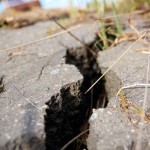

A California Legislator on Friday introduced a bill that would prevent construction on seismic fissures.
Senate Bill 1155 would mandate that developers and city officials treat an unzoned earthquake fault line just like a zoned earthquake fault line, plus add an additional setback of 75 feet.
California has about 7,000 miles of earthquake faults that have been mapped and identified, and more than 5,000 miles of these faults have also been zoned so that developers cannot build 50 feet near the fault line, unless an exception has been granted.
 Nearly 1,800 miles of faults have not yet been zoned, and the difference between a zoned earthquake fault and an unzoned earthquake fault is about 50 to 75 feet.
Nearly 1,800 miles of faults have not yet been zoned, and the difference between a zoned earthquake fault and an unzoned earthquake fault is about 50 to 75 feet.
Some developers have been taking advantage of this loophole for mapped, but unzoned faults to ignore the fault line completely, according to the bill’s author, state Sen. Ted Lieu, D-Redondo Beach.
Prompting Lieu’s bill was a recent investigative series by the Los Angeles Times that showed that officials had approved numerous residential and commercial projects in Los Angeles and Santa Monica that were improperly built over the Hollywood and Santa Monica faults, which had been mapped but were not yet zoned. After the projects were approved, it was later determined some sit directly on top of fault lines.
“Building on fault lines is unacceptable,” said Lieu, who is campaigning to succeed Congressman Henry Waxman for his Congressional seat. “When a major earthquake occurs, as it inevitably will, these errant building decisions could literally mean the difference between survival – and widespread panic and catastrophic losses.”
Lieu noted that California has endured three deadly earthquakes in the past 43 years: the 1971 Sylmar-San Fernando Earthquake; the 1989 Loma Prieta Earthquake; and the 1994 Northridge Earthquake.
The Northridge Earthquake cost an estimated at $15 billion in insured damages. The 20th anniversary of the quake was in January.
In response to the 1971 earthquake, state lawmakers passed the Alquist-Priolo Earthquake Fault Zoning Act to address the hazard of surface fault ruptures and prevent the construction of residential and commercial buildings on top of known active faults.
Under this law, the State Geologist is required to establish Earthquake Fault Zones around active trace faults and to issue appropriate maps. The maps are then distributed to all cities, counties and state agencies for their use in planning and controlling new or renewed construction. Local agencies then must regulate most development projects within these Earthquake Fault Zones.
In theory, before a project can be permitted by a planning agency, cities and counties must first require a geologic investigation to demonstrate that the proposed dwellings will not be built across active faults. This requirement includes an evaluation and a written report for each specific site prepared by a licensed geologist. According to existing law, if an active fault is found, a structure for human occupancy cannot be placed over the trace of the fault.
Lieu previously requested additional funding to complete the remaining zoning for the 1,800 miles of unzoned fault lines. Gov. Jerry Brown’s proposed budget released in January now includes funding to address this shortfall.
SB 1155 faces a policy review, and an initial hearing date has not been set.